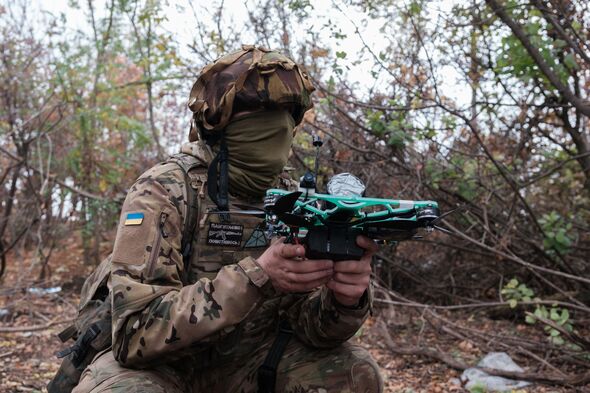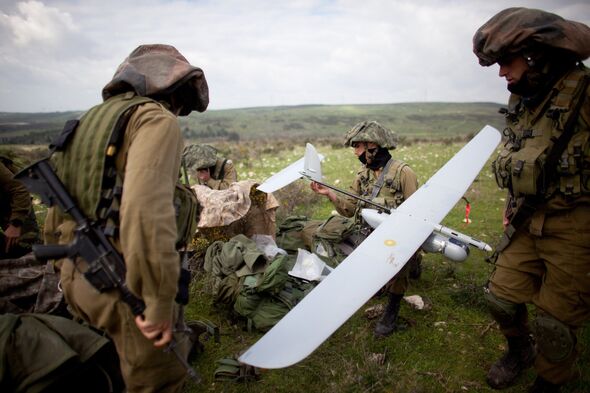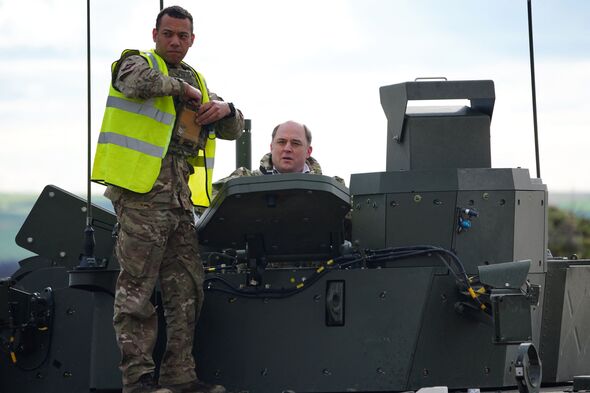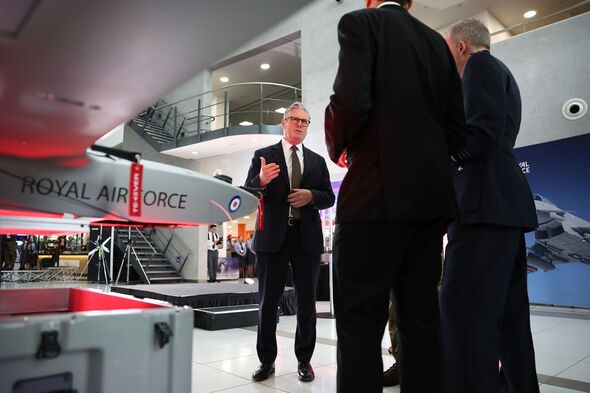Express’ Conor Wilson discusses drone warfare capability
The evolution of drone warfare highlighted by the Russia-Ukraine war has left the British Army playing “catch up,” defence experts have warned. Following Vladimir Putin’s full-scale invasion of his neighbour, the West rushed billions of dollars of weapons into the country in the belief that the war would be fought in a similar way to the conflicts of the 20th century, with mostly conventional weaponry.
However, since the outset of war in 2022, the use of drones has increased to such an extent that they now account for as many as 80% of Russian fatalities on some operations, according to Roman Kostenko, the chairman of the defence and intelligence committee in Ukraine’s Parliament. Drones now rule the battlefield. They cost a fraction of the price of conventional missiles, they serve as both a reconnaissance tool and a weapon and can be redirected mid-flight onto a moving target. The evolution of drone warfare in a matter of years means that nation states are playing catch-up, scrambling to adjust to the changing nature of warfare at a rapid pace.

Drones now account for around 80% of casualties in the Ukrainian war. (Image: Getty)
The UK is no different. Since 2022, it has worked to adapt the force to meet the threats presented in Europe and beyond, but equipping the armed forces with the tools they need requires a transformation that goes beyond simply buying drones.
Academic and former Parachute Regiment officer Andrew Fox, who completed three tours in Afghanistan, including one attached to the US Army Special Forces, says that the ability of global drone production to meet demand is leaving many nations short of the very equipment being used to great effect in Ukraine.
He told the Daily Express: “In terms of scarcity, it is actually very common, everybody is playing catch up on drones.
“We are certainly seeing that in Ukraine, where they are buying loads of off-the-shelf stuff, and even now, you will still find crowdfunding to buy drones.
“Even the Israeli Defence Force, they have been great with drones, but they have not had anywhere near enough. It has taken a long time to trickle down to your bog standard infantry, and lots of them are using off the shelf stuff they have bought themselves.”

Countries across the world are scrambling to procure sufficient quantities of drones. (Image: Getty)
Karl Rosander, CEO and co-founder of Nordic Air Defence, agrees that drones have become central to modern warfare.
He said: “The conflict in Ukraine has made it clear that drones, particularly one-way attack drones and electronic warfare tools like jammers and spoofers, are no longer peripheral assets.
“They’ve become central to modern warfare, fundamentally altering how armed forces approach both strategy and capability.
“In response, many nations are rethinking their procurement models. Traditional, lengthy acquisition cycles are giving way to more agile, responsive systems that allow for rapid deployment and ongoing adaptation.
“There’s a growing recognition that remaining competitive in this space requires both speed and flexibility, as well as closer collaboration with technology providers.”
An expert says a “lengthy acquisition cycle” is a euphemistic way of describing procurement in the MOD. The process has a track record of being laborious and elongated, often leaving frontline troops short of vital equipment.
According to the MOD’s Strategic Defence Review (SDR), the average time to take a project valued in excess of £20 million from concept to contract is six and a half years.
A 2020 report by the National Audit Office found that on average, “significant capabilities” are delayed by 26 months.
For Fox, the lack of drones is symptomatic of a wider issue of a deficiency of modern defence equipment.
He added: “We know the British Army is underfunded, we know they don’t have enough tanks, never mind enough drones.
“The bottom line is, we have troops deploying with armoured vehicles that are older than their parents, maybe even their grandparents in some cases, we’re not in a great state.
“The lack of drones is just symptomatic of a much wider malaise.”

Drones are just one capability weighed down by lengthy procurement processes. (Image: Getty)
It remains unclear how many drones the armed forces currently possess, with equipment stocks for the newest models not accounted for in the MOD’s annual releases.
According to the latest report published in February, just 150 uncrewed aircraft systems are currently in service, a figure which is roughly 10% of the total currently produced by Russia in a single day.
That amount has led to calls for the MOD to turbocharge its procurement of drones with a wide range of capabilities, the urgency of which is intensified by the prospect of a future mass deployment to Eastern Europe.
Shadow Defence Minister James Cartlidge is among those calling on the Government to act quicker in procuring the technology that is proving so effective in the Ukrainian theatre.
He told the Daily Express: “It was recently estimated that Russia is taking down about 10,000 Ukrainian military drones per month.
“On the Ukrainian side, their incredible industrial effort – despite all the bombing – is on track to manufacture 2.5-3 million military-use drones this year. So, how many such drones have Labour ordered for our own armed forces since the General Election?
“You would think the figure might at least be in the thousands. In fact, the answer is: three.
“A written answer to me from the MOD confirms they’ve ordered just a trio of reconnaissance drones since last July, and not a single attack drone – such a potent part of the war effort on both sides since Russia’s illegal, all-out invasion in 2022.”
The MOD have rejected the claims, insisting that the answer given by Procurement Minister Maria Eagle related solely to reconnaissance drones and did not take into account the purchases of any other form, although they declined to give any further figures.

Starmer has previously emphasised the importance of acquiring and developing drones. (Image: Getty)
However, there is concern that even if drones were plentiful and procurement processes were simplified, the infrastructure around the training, maintenance, and use of the equipment would be unable to keep up.
Labour MP and former Royal Marine Fred Thomas said: “The Ukraine war is demonstrating how obsolete training people in traditional ways is becoming, the majority of casualties are being sustained by drones, not rifles, yet we are still lining soldiers up and getting them to shoot stationary wooden targets.”
On the issues stopping progression in the UK, he added: “The regulatory environment impacts the ability to train and develop hardware, software, tactics and professional soldiers.
“If you are a company trying to develop a drone, you can barely fly it in the UK, so how are you going to develop something without practising flying it because the regulatory environment is so tight.
“If you want to train soldiers on how to implement drones into your tactics, not that we have got enough drones to do that but theoretically if we did, you’d need to get permission from the Military Air Authority to fly those drones and to make it in any way realistic to what is happening in Ukraine.
“You would need to practise flying 30 of them at once to practise swarming them, and you just would not get permission to do that. That is a huge impediment to training.
“If you want to start live firing these drones, you’d need a range to do it – you can barely fire a mortar shell in the UK, so how are we going to start firing drones that explode?
“Electromagnetic spectrum stuff, you want to practise blocking out some frequencies, sucking data here, you’re going to start interfering with civilians who live near training areas and you are never going to get permission to do that.”

The British Army recently trialled defeating swarms of drones with an directed energy weapon. (Image: PA)
The British Army is making some progress. Last month, the MOD confirmed that UK soldiers had successfully trialled their ability to detect, track, and target a swarm of drones for the first time, representing a major milestone in the training of troops in this new form of warfare.
The Government says that it has invested more than £40 million in Radiofrequency Directed Energy Weapon (RF DEW) research and development, with the Government ringfencing 10% of the defence budget for spending on novel technologies from 2025-2026.
The weapon, which was trialled in West Wales, uses high-frequency radio waves to disrupt or damage critical electronic components inside drones, causing them to crash or malfunction.
At an estimated cost of 10p per shot fired, if developed into operational service, it could provide a cost-effective complement to traditional missile-based air defence systems.
RF DEW systems can defeat airborne targets at ranges of up to 1km and are effective against threats which cannot be jammed using electronic warfare.

















